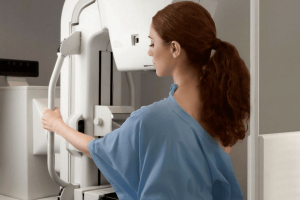Overdiagnosis a Significant Risk of Mammogram Screening
 Mammography screening is a highly recommended medical procedure in the United States for all women ages 40 and older, yet recent studies indicate overdiagnosis is a serious concern which is not commonly shared with patients. As many as one out of every three women who undergo regular mammograms end up being treated with surgery, radiation and/or chemotherapy which may not only be unnecessary but can trigger the development of additional cancer cells. Although thermography offers a completely safe and highly effective alternative, most women are not fully informed of this option which has been approved by the FDA since 1982.
Mammography screening is a highly recommended medical procedure in the United States for all women ages 40 and older, yet recent studies indicate overdiagnosis is a serious concern which is not commonly shared with patients. As many as one out of every three women who undergo regular mammograms end up being treated with surgery, radiation and/or chemotherapy which may not only be unnecessary but can trigger the development of additional cancer cells. Although thermography offers a completely safe and highly effective alternative, most women are not fully informed of this option which has been approved by the FDA since 1982.
Screening Recommendations Impact All Women Over Forty
Various medical organizations recommend the implementation of an annual (or bi annual) mammogram for all women between the ages of 40 and 50; high risk women are told to begin screening in their 30's. Independent medical professionals are permitted to review the available data and provide their own recommendations based on unique circumstances, yet few share the full scope of risks associated with these procedures with their patients. False positives are notoriously common with mammography, particularly in younger women who initiate screening earlier in life. As many as half of all women who undergo ten consecutive years of testing will receive a false positive result which can lead to repeat testing, biopsies and the possibility of unnecessary cancer treatment.
Many Breast Tumors Shrink on Their Own
A significant percentage of cancers detected via mammography have been shown to spontaneously shrink over time and independent of any medical interventions. An article in Lancet Oncology reported that a mere 6.5 percent of "abnormal breast findings" actually developed into a malignant form of cancer; they also revealed that most of these abnormal findings were non existent six years after their initial appearance on a mammogram. Because doctors are unable to determine which abnormal tissue masses will develop into a malignancy down the road, a general one size fits all approach of treatment recommendation is applied in the vast majority of situations; women, however, are typically denied access to all the facts involved with this delicate and personal health decision.
Overdiagnosis Leads to Unnecessary Treatment
A recent Danish study estimated that as many as one out of every three women who utilize routine mammogram screening will undergo one or more unnecessary forms of cancer treatment such as surgery, radiation and/or chemotherapy. Another study in the New England Journal of Medicine reported similar findings and concluded that more than 70,000 women were overdiagnosed with breast cancer in 2008 alone. This figure translated to a full 31 percent of those who received regular screening. The risk of overdiagnosis is increased in women who begin screening earlier in life when compared to those who wait until they are 50 or older.
Screening Poses Serious Health Implications
Some medical providers acknowledge and share the fact that mammography screening in and of itself does increase the chances of tumor development as a result of radiation received during the procedure, although most still underestimate the risks. Little is likely to be mentioned regarding the fact that some women are at an extremely high risk of overdiagnosis (particularly those with a genetic predisposition to breast cancer who began menstruating at an early age) while genuinely malignant tumors in others may be completely undetected by a mammography device. The risks involved with any of the above scenarios are high, as unnecessary treatment often follows false positive results while those with dangerous tumors that go undetected may find their cancer progresses in short order.
Breast Cancer Treatments Create Significant Side Effects
The decision to undergo one or more forms of breast cancer treatment is a serious decision with side effects that not only reduce quality of life but may actually shorten the life expectancy of some women. Surgeries are invasive and cause pain and suffering while radiation and chemotherapy treatments may actually encourage the development of cancers within different areas of the body. Informed consent requires that medical care providers fully inform their patients of the benefits and risks of any procedure or treatment under consideration, yet in the case of cancer therapies, negative aspects of these highly profitable medical treatments are often downplayed.
A Highly Effective Alternative
Another aspect of informed consent requires all providers to inform patients of any alterative treatments or procedures available. Since 1982, thermography has been approved by the FDA for breast cancer screening, yet few women are aware that an alternative even exists. Thermography has been shown to detect dangerous changes in breast tissue at far earlier stages than traditional screening and does not subject women to the high rate of false positives common with mammography. Lifestyle changes alone are often sufficient to encourage tumor shrinkage when the results of a thermograph reveal the early development of abnormal breast tissue, yet the technology remains highly underutilized. Perhaps over time, as more women realize their medical care providers may have been violating the informed content law by not fully informing them of the big picture involved with mammography, the established health care community will reform its policies to provide more accurate data to health care consumers.
